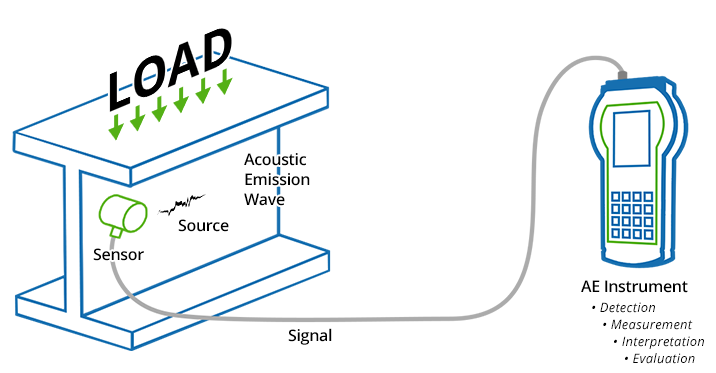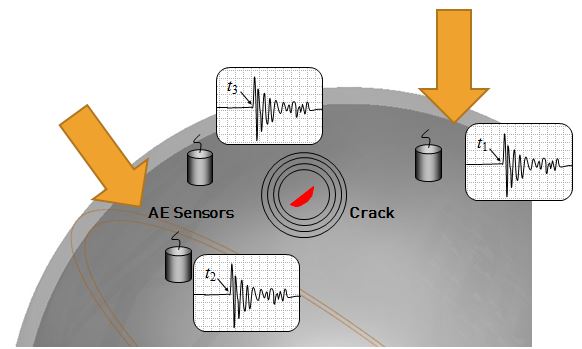What is Acoustic emission testing?
ACOUSTIC EMISSION TESTING (AET)
Acoustic Emission Test is a type of Non – Destructive Test method generally used for detecting and locating imperfections in mechanically loaded structures or components.
Flaw origination and progression in a stressed component can be identified by acoustic emission test method.This can be done when the component is subjected to repetitive or continuous stress.
PRINCIPLE OF ACOUSTIC EMISSION TESTING AET:
When a component with discontinuities is subjected to mechanical load or stress it releases energy. This energy travels in the form of high frequency stress waves.
These waves or oscillations are received with the use of sensors which in turn converts the energy into voltage. This voltage is electronically amplified with the use of timing circuits and further processed as AE signal data.
STAGES IN ACOUSTIC EMISSION TESTING (AET):
- External forces acting on a body; the resulting stress causes deformation with it.
- The stress on the material causes local plastic deformation and a crack at specific places. This crack/breakdown produces acoustic emission.
- Acoustic emission in an elastic wave that travels outward from the source (crack) & reaches the sensor.
- Sensor produces electrical signal (voltage) which is processed further to acquire data.
SOURCE OF ACOUSTIC EMISSION:
- Plastic deformation due to dislocation movement and yielding.
- Break initiated from fragments of oxide, carbide and sulfide.
- Failure due to non-metallic inclusions lying between metal grains.
- The breaking of these non-metallic components is the main source of acoustic emission.
- Growing cracks in the metal surface is the best recognized source of high amplitude acoustic emissions.
- Corrosion products forming on the crack surfaces.
- Energy released from the stress field is the source of acoustic emission.
ADVANTAGES OF (AET):
- Pre-service and in-service testing can be done.
- Online monitoring of components and system is possible.
- Locating defects and leak detecting.
- Less geometry sensitive.
- Less intrusive.
- Real time evaluation and remote scanning is possible.
LIMITATIONS OF ACOUSTIC EMISSION TESTING:
- Poor repeatability.
- Influence of ambient noise and attenuation of signals may result in poor output.
- Sophisticated data processing devices are required.
- AE results are set firmly to the knowledge and experience of the service provider.
APPLICATIONS OF ACOUSTIC EMISSION TESTING:
- AE testing is employed in many industries such as refineries, pipelines, power generation, structural, and air-craft.
- AE testing and evaluation is also used by offshore oil platforms and paper mills.
- Structures frequently tested using AE method include bridges, tunnels, towers, tanks, pipes, cranes & heavy industrial equipment.
NDT services in coimbatore
For more details about the Non Destructive Testing on materials, NDT inspection testing, welding procedure WPS, PQR, welder qualification / certification of pressure, NDT training, qc Courses on welding ,reach us at https://aqcinspection.com/training/
Also know more about other NDT methods in our blog sites.https://advancedqualitycentre.blogspot.com . https://ndtcenter.blogspot.com our website https://aqcinspection.com/news-events/ for many more blogs



Comments
Post a Comment